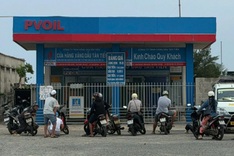
Goods at Haiphong Port in northern port city of Haiphong.
Trade approaches USD 500 billion milestone
From January 1 to July 15, Vietnam’s total trade turnover reached USD 470.65 billion, comprising USD 239.2 billion in exports and USD 231.45 billion in imports. The country posted a trade surplus of USD 7.75 billion during the period, according to the General Department of Customs under the Ministry of Finance.
In the first 15 days of July alone, trade value reached USD 38.17 billion, with exports at USD 19 billion and imports slightly higher at USD 19.17 billion. June recorded USD 75.59 billion in trade, while May saw a record high of USD 78.64 billion, the largest monthly figure of the year so far.
Vietnam is on track to surpass USD 500 billion in total trade by the end of July.
Electronics and high-tech products continued to lead export earnings in early July. Computers, electronics, and components generated USD 3.88 billion, followed by phones and parts at USD 2.52 billion, and machinery at USD 2.3 billion. Apparel and footwear brought in USD 1.82 billion and over USD 1 billion, respectively.
Exports of aquatic products, fruits and vegetables, wooden furniture, vehicles, toys, and sporting goods also contributed significantly.
On the import side, computers and electronic components led with USD 6.55 billion, while machinery and equipment followed with USD 2.7 billion, reflecting heightened production demand across manufacturing sectors.
The Ministry of Industry and Trade (MoIT) attributed the rebound to policies that support domestic production and promote export market expansion.
Racing toward year-end targets amid global uncertainty
As the second half of 2025 begins, exporters are intensifying efforts to meet annual goals. However, slowing global growth, escalating geopolitical tensions, and climate disruptions continue to cast uncertainty over international trade.
Le Phung Hao, Chairman of Global AAA Consulting, urged businesses to restructure, adopt digital tools, boost productivity, and improve competitiveness. He emphasized the importance of market diversification and greater use of free trade agreements to reduce dependence on a few major buyers.
Speaking on Vietnam–US trade, Professor Tran Ngoc Anh of Indiana University described the US as a key export destination despite evolving trade policies.
“Even with tariffs in place, opportunities remain,” he said. “As supply chains shift, Vietnam should expand imports from the US, strengthen supporting industries, and invest in technology and management to move up the value chain.”
While challenges are expected to persist into 2026, Vietnam hopes progress in tariff negotiations could enhance its competitive edge and sustain foreign investment.
The MoIT affirmed its commitment to pursuing fair and reciprocal trade agreements with the US, strengthening early-warning mechanisms, supporting trade defence measures, and assisting exporters in meeting global technical standards.




















